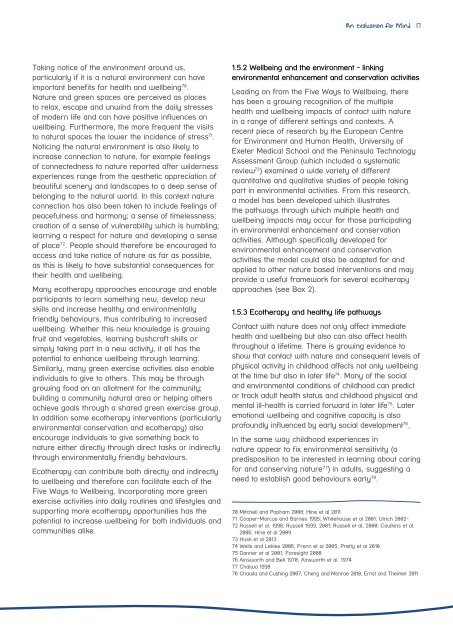Ecominds-effects-on-mental-wellbeing-evaluation-report
Ecominds-effects-on-mental-wellbeing-evaluation-report
Ecominds-effects-on-mental-wellbeing-evaluation-report
You also want an ePaper? Increase the reach of your titles
YUMPU automatically turns print PDFs into web optimized ePapers that Google loves.
An evaluati<strong>on</strong> for Mind 17Taking notice of the envir<strong>on</strong>ment around us,particularly if it is a natural envir<strong>on</strong>ment can haveimportant benefits for health and <strong>wellbeing</strong> 70 .Nature and green spaces are perceived as placesto relax, escape and unwind from the daily stressesof modern life and can have positive influences <strong>on</strong><strong>wellbeing</strong>. Furthermore, the more frequent the visitsto natural spaces the lower the incidence of stress 71 .Noticing the natural envir<strong>on</strong>ment is also likely toincrease c<strong>on</strong>necti<strong>on</strong> to nature, for example feelingsof c<strong>on</strong>nectedness to nature <strong>report</strong>ed after wildernessexperiences range from the aesthetic appreciati<strong>on</strong> ofbeautiful scenery and landscapes to a deep sense ofbel<strong>on</strong>ging to the natural world. In this c<strong>on</strong>text naturec<strong>on</strong>necti<strong>on</strong> has also been taken to include feelings ofpeacefulness and harm<strong>on</strong>y; a sense of timelessness;creati<strong>on</strong> of a sense of vulnerability which is humbling;learning a respect for nature and developing a senseof place 72 . People should therefore be encouraged toaccess and take notice of nature as far as possible,as this is likely to have substantial c<strong>on</strong>sequences fortheir health and <strong>wellbeing</strong>.Many ecotherapy approaches encourage and enableparticipants to learn something new, develop newskills and increase healthy and envir<strong>on</strong><strong>mental</strong>lyfriendly behaviours, thus c<strong>on</strong>tributing to increased<strong>wellbeing</strong>. Whether this new knowledge is growingfruit and vegetables, learning bushcraft skills orsimply taking part in a new activity, it all has thepotential to enhance <strong>wellbeing</strong> through learning.Similarly, many green exercise activities also enableindividuals to give to others. This may be throughgrowing food <strong>on</strong> an allotment for the community;building a community natural area or helping othersachieve goals through a shared green exercise group.In additi<strong>on</strong> some ecotherapy interventi<strong>on</strong>s (particularlyenvir<strong>on</strong><strong>mental</strong> c<strong>on</strong>servati<strong>on</strong> and ecotherapy) alsoencourage individuals to give something back t<strong>on</strong>ature either directly through direct tasks or indirectlythrough envir<strong>on</strong><strong>mental</strong>ly friendly behaviours.Ecotherapy can c<strong>on</strong>tribute both directly and indirectlyto <strong>wellbeing</strong> and therefore can facilitate each of theFive Ways to Wellbeing. Incorporating more greenexercise activities into daily routines and lifestyles andsupporting more ecotherapy opportunities has thepotential to increase <strong>wellbeing</strong> for both individuals andcommunities alike.1.5.2 Wellbeing and the envir<strong>on</strong>ment - linkingenvir<strong>on</strong><strong>mental</strong> enhancement and c<strong>on</strong>servati<strong>on</strong> activitiesLeading <strong>on</strong> from the Five Ways to Wellbeing, therehas been a growing recogniti<strong>on</strong> of the multiplehealth and <strong>wellbeing</strong> impacts of c<strong>on</strong>tact with naturein a range of different settings and c<strong>on</strong>texts. Arecent piece of research by the European Centrefor Envir<strong>on</strong>ment and Human Health, University ofExeter Medical School and the Peninsula TechnologyAssessment Group (which included a systematicreview 73 ) examined a wide variety of differentquantitative and qualitative studies of people takingpart in envir<strong>on</strong><strong>mental</strong> activities. From this research,a model has been developed which illustratesthe pathways through which multiple health and<strong>wellbeing</strong> impacts may occur for those participatingin envir<strong>on</strong><strong>mental</strong> enhancement and c<strong>on</strong>servati<strong>on</strong>activities. Although specifically developed forenvir<strong>on</strong><strong>mental</strong> enhancement and c<strong>on</strong>servati<strong>on</strong>activities the model could also be adapted for andapplied to other nature based interventi<strong>on</strong>s and mayprovide a useful framework for several ecotherapyapproaches (see Box 2).1.5.3 Ecotherapy and healthy life pathwaysC<strong>on</strong>tact with nature does not <strong>on</strong>ly affect immediatehealth and <strong>wellbeing</strong> but also can also affect healththroughout a lifetime. There is growing evidence toshow that c<strong>on</strong>tact with nature and c<strong>on</strong>sequent levels ofphysical activity in childhood affects not <strong>on</strong>ly <strong>wellbeing</strong>at the time but also in later life 74 . Many of the socialand envir<strong>on</strong><strong>mental</strong> c<strong>on</strong>diti<strong>on</strong>s of childhood can predictor track adult health status and childhood physical and<strong>mental</strong> ill-health is carried forward in later life 75 . Lateremoti<strong>on</strong>al <strong>wellbeing</strong> and cognitive capacity is alsoprofoundly influenced by early social development 76 .In the same way childhood experiences innature appear to fix envir<strong>on</strong><strong>mental</strong> sensitivity (apredispositi<strong>on</strong> to be interested in learning about caringfor and c<strong>on</strong>serving nature 77 ) in adults, suggesting aneed to establish good behaviours early 78 .70 Mitchell and Popham 2008; Hine et al 201171 Cooper-Marcus and Barnes 1995; Whitehouse et al 2001; Ulrich 2002-72 Russell et al. 1998; Russell 1999, 2001; Russell et al, 2000; Caulkins et al.2006; Hine et al 200973 Husk et al 201374 Wells and Lekies 2006, Frenn et al 2005, Pretty et al 201075 Danner et al 2001, Foresight 200876 Ainsworth and Bell 1970, Ainsworth et al. 197477 Chalwa 199878 Chawla and Cushing 2007, Cheng and M<strong>on</strong>roe 2010, Ernst and Theimer 2011



